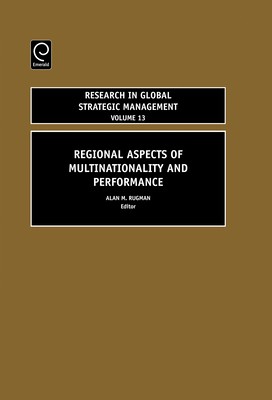
- We will send in 10–14 business days.
- Author: Alan M Rugman
- Publisher: Jai Press Inc.
- ISBN-10: 0762313951
- ISBN-13: 9780762313952
- Format: 18.1 x 23.4 x 3.6 cm, kieti viršeliai
- Language: English
- SAVE -10% with code: EXTRA
Regional Aspects of Multinationality and Performance (e-book) (used book) | bookbook.eu
Reviews
Description
This volume contains recent chapters dealing with empirical tests of the relationship between multinationality (M) and performance (P). This is a traditional topic in the area of international business, but recently there has been renewed interest, partly due to theoretical advances such as the regionalization thesis of Rugman and Verbeke (in contrast to the previous assumption of uniform internationalization) and partly due to better and more detailed data on the geographic dispersion of activities now available from the annual reports of large firms, most of which are multinational enterprises (MNEs). In this literature, P, as a dependent variable, is broadly determined by the degree of multinationality, M, where M is usually proxied by the ratio of foreign (F) to total (T) sales or assets, i.e. (F/T). There is either a linear, quadratic, or cubic (S curve) fit, allowing for controls such as size of the firm; industry grouping, organizational learning effect over time, etc. Recently, this M and P literature has included regional aspects of (F/T) and performance, for example performance has looked at return on foreign assets (ROFA). In short, new accounting standards affecting most of the worlds MNEs now make it possible to adopt both a new dependent variable (for performance) and a new independent variable (for multinationality). Performance can now capture the return on foreign assets (ROFA), and just the return on total assets (ROTA). Multinationality is now available on a regional basis, i.e. the ratio of regional (R) to total (T) sales R/T. This offers better information on the strategic performance of an MNE, in comparison to the traditional metric of the return of foreign - to total sales or assets F/T. This volume will publish 10 chapters at the forefront of research on this reinvigorated topic of the regional aspects of multinationality and performance. It provides research at the forefront of the regional aspects of multinationality and performance. It deals with empirical tests of the relationship between multinationality and performance. It considers the effect that new accounting standards for the worlds MNEs have on multinationality and performance. This book series is available electronically at website.
EXTRA 10 % discount with code: EXTRA
The promotion ends in 21d.13:42:30
The discount code is valid when purchasing from 10 €. Discounts do not stack.
- Author: Alan M Rugman
- Publisher: Jai Press Inc.
- ISBN-10: 0762313951
- ISBN-13: 9780762313952
- Format: 18.1 x 23.4 x 3.6 cm, kieti viršeliai
- Language: English English
This volume contains recent chapters dealing with empirical tests of the relationship between multinationality (M) and performance (P). This is a traditional topic in the area of international business, but recently there has been renewed interest, partly due to theoretical advances such as the regionalization thesis of Rugman and Verbeke (in contrast to the previous assumption of uniform internationalization) and partly due to better and more detailed data on the geographic dispersion of activities now available from the annual reports of large firms, most of which are multinational enterprises (MNEs). In this literature, P, as a dependent variable, is broadly determined by the degree of multinationality, M, where M is usually proxied by the ratio of foreign (F) to total (T) sales or assets, i.e. (F/T). There is either a linear, quadratic, or cubic (S curve) fit, allowing for controls such as size of the firm; industry grouping, organizational learning effect over time, etc. Recently, this M and P literature has included regional aspects of (F/T) and performance, for example performance has looked at return on foreign assets (ROFA). In short, new accounting standards affecting most of the worlds MNEs now make it possible to adopt both a new dependent variable (for performance) and a new independent variable (for multinationality). Performance can now capture the return on foreign assets (ROFA), and just the return on total assets (ROTA). Multinationality is now available on a regional basis, i.e. the ratio of regional (R) to total (T) sales R/T. This offers better information on the strategic performance of an MNE, in comparison to the traditional metric of the return of foreign - to total sales or assets F/T. This volume will publish 10 chapters at the forefront of research on this reinvigorated topic of the regional aspects of multinationality and performance. It provides research at the forefront of the regional aspects of multinationality and performance. It deals with empirical tests of the relationship between multinationality and performance. It considers the effect that new accounting standards for the worlds MNEs have on multinationality and performance. This book series is available electronically at website.


Reviews